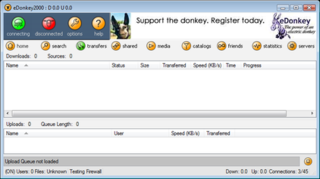
Peer-to-peer (P2P) computing or networking is a distributed application architecture that partitions tasks or workloads between peers. Peers are equally privileged, equipotent participants in the network, forming a peer-to-peer network of nodes. In addition, a personal area network (PAN) is also in nature a type of decentralized peer-to-peer network typically between two devices.

eDonkey2000 was a peer-to-peer file sharing application developed by US company MetaMachine, using the Multisource File Transfer Protocol. It supported both the eDonkey2000 network and the Overnet network.

A distributed hash table (DHT) is a distributed system that provides a lookup service similar to a hash table. Key–value pairs are stored in a DHT, and any participating node can efficiently retrieve the value associated with a given key. The main advantage of a DHT is that nodes can be added or removed with minimum work around re-distributing keys. Keys are unique identifiers which map to particular values, which in turn can be anything from addresses, to documents, to arbitrary data. Responsibility for maintaining the mapping from keys to values is distributed among the nodes, in such a way that a change in the set of participants causes a minimal amount of disruption. This allows a DHT to scale to extremely large numbers of nodes and to handle continual node arrivals, departures, and failures.
BitTorrent, also referred to simply as torrent, is a communication protocol for peer-to-peer file sharing (P2P), which enables users to distribute data and electronic files over the Internet in a decentralized manner. The protocol is developed and maintained by Rainberry, Inc., and was first released in 2001.

A cryptographic hash function (CHF) is a hash algorithm that has special properties desirable for a cryptographic application:
An anonymous P2P communication system is a peer-to-peer distributed application in which the nodes, which are used to share resources, or participants are anonymous or pseudonymous. Anonymity of participants is usually achieved by special routing overlay networks that hide the physical location of each node from other participants.
In cryptography, Tiger is a cryptographic hash function designed by Ross Anderson and Eli Biham in 1995 for efficiency on 64-bit platforms. The size of a Tiger hash value is 192 bits. Truncated versions can be used for compatibility with protocols assuming a particular hash size. Unlike the SHA-2 family, no distinguishing initialization values are defined; they are simply prefixes of the full Tiger/192 hash value.

Magnet is a URI scheme that defines the format of magnet links, a de facto standard for identifying files (URN) by their content, via cryptographic hash value rather than by their location.
The eDonkey Network is a decentralized, mostly server-based, peer-to-peer file sharing network created in 2000 by US developers Jed McCaleb and Sam Yagan that is best suited to share big files among users, and to provide long term availability of files. Like most sharing networks, it is decentralized, as there is no central hub for the network; also, files are not stored on a central server but are exchanged directly between users based on the peer-to-peer principle.
The Kad network is a peer-to-peer (P2P) network which implements the Kademlia P2P overlay protocol. The majority of users on the Kad Network are also connected to servers on the eDonkey network, and Kad Network clients typically query known nodes on the eDonkey network in order to find an initial node on the Kad network.

In cryptography and computer science, a hash tree or Merkle tree is a tree in which every "leaf" node is labelled with the cryptographic hash of a data block, and every node that is not a leaf is labelled with the cryptographic hash of the labels of its child nodes. A hash tree allows efficient and secure verification of the contents of a large data structure. A hash tree is a generalization of a hash list and a hash chain.

eMule is a free peer-to-peer file sharing application for Microsoft Windows. Started in May 2002 as an alternative to eDonkey2000, eMule now connects to both the eDonkey network and the Kad network. The distinguishing features of eMule are the direct exchange of sources between client nodes, fast recovery of corrupted downloads, and the use of a credit system to reward frequent uploaders. Furthermore, eMule transmits data in zlib-compressed form to save bandwidth.
In computing, eD2k links (ed2k://) are hyperlinks used to denote files stored on computers connected to the eDonkey filesharing P2P network.
This is a glossary of jargon related to peer-to-peer file sharing via the BitTorrent protocol.
In the BitTorrent file distribution system, a torrent file or meta-info file is a computer file that contains metadata about files and folders to be distributed, and usually also a list of the network locations of trackers, which are computers that help participants in the system find each other and form efficient distribution groups called swarms. Torrent files are normally named with the extension .torrent.

Retroshare is a free and open-source peer-to-peer communication and file sharing app based on a friend-to-friend network built by GNU Privacy Guard (GPG). Optionally peers may exchange certificates and IP addresses to their friends and vice versa.
Torrent poisoning is intentionally sharing corrupt data or data with misleading, deceiving file names using the BitTorrent protocol. This practice of uploading fake torrents is sometimes carried out by anti-infringement organisations as an attempt to prevent the peer-to-peer (P2P) sharing of copyrighted content, and to gather the IP addresses of downloaders.

Twister is a decentralized and experimental peer-to-peer microblogging program which uses end-to-end encryption to safeguard communications. Based on BitTorrent and Bitcoin-like protocols, it has been likened to a distributed version of Twitter.

The InterPlanetary File System (IPFS) is a protocol, hypermedia and file sharing peer-to-peer network for storing and sharing data in a distributed hash table. By using content addressing, IPFS uniquely identifies each file in a global namespace that connects IPFS hosts, creating a resilient system of file storage and sharing.

ZeroNet is a decentralized web-like network of peer-to-peer users, created by Tamas Kocsis in 2015, programming for the network was based in Budapest, Hungary; is built in Python; and is fully open source. Instead of having an IP address, sites are identified by a public key. The private key allows the owner of a site to sign and publish changes, which propagate through the network. Sites can be accessed through an ordinary web browser when using the ZeroNet application, which acts as a local webhost for such pages. In addition to using bitcoin cryptography, ZeroNet uses trackers from the BitTorrent network to negotiate connections between peers. ZeroNet is not anonymous by default, but it supports routing traffic through the Tor network.










